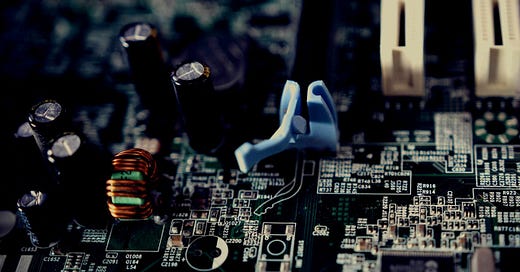😲 India’s First Semiconductor Plant is Here!
India is taking yet another step towards self-reliance, this time in the field of semiconductors. But will its ambitious plans work out?
Much like mehengai and unwanted guests, supply chain shortages are refusing to leave us alone.
We've seen shortages of all kinds: crude oil, edible oil, and containers. Oh, and those semiconductor chips (the under-appreciated heroes whose importance we didn't realise until the pandemic struck)!
This semiconductor shortage has driven down automobile sales as companies just don’t have enough semiconductors to produce the desired number of cars.
Both Hyundai and Maruti saw sales fall by 5% in April (however Tata Motors is on a roll and saw sales increase 74%).
Not just that, this shortage is set to increase the prices of basic electronics that we use by over 10%!
So, what are we doing to solve this problem?
We’ve launched one of the first-ever and largest semiconductor manufacturing plants.
But why so late?
ReadOn!
🌳 The Root Cause
The semiconductor shortage has its roots in the pandemic.
Covid led to a total shutdown of factories. In those few months of total shutdown, the supply chain crisis got so bad that it was predicted the problem would continue till 2023!
And to add fuel to this fire, China from whom we import 37% of our semiconductors, has once again announced lockdowns, cutting down our supplies.
Plus, the whole Russia-Ukraine war has anyway caused a shortage of materials needed to make these chips.
In a nutshell:
But enough about these causes. We’ve discussed these time and again.
Let’s instead focus on the actual root cause: India’s dependence on imports of semiconductors.
⚡The India Problem
Why is India so reliant on other countries for items that are of such utmost importance?
Well, it's not out of choice.
India is a country with very few resources.
This is exactly why we have to import coal, oil (both edible and crude) and even semiconductors.
You see, to launch semiconductor fabrication (manufacturing) plants, we need minerals like gallium, silicon, indium, and other such complicated ones.
And we have a critical dearth of such minerals.
But can't we just import the materials and produce the semiconductors here? That way we’ll be less dependent on other countries.
Well, yes. That’s kind of what we’re planning to do.
But these materials are not all that we need to make semiconductors.
We need constant electricity, a massive amount of running water and huge investments to set up semiconductor plants in India.
And for the longest time, it wasn’t possible for our country to assure companies that it would be able to provide these amenities.
So, these companies flocked to other nations like South Korea, Taiwan and Vietnam.
This did not just leave us completely dependent on imports (leading to a $24 billion import bill) but also led to the whole supply chain crisis (as exporters were concentrated in just a few countries).
This is exactly why we’re now going the aatmanirbhar way and finally setting up semiconductor plants in India.
In fact, the first one is being set up in Karnataka by ISMC, a joint venture by Abu Dhabi-based Next Orbit Ventures and Israel’s Tower Semiconductor (which Intel plans to soon acquire). The venture will invest Rs. 22,900 crores to set up this plant.
The plant will not just make us a little less dependent on semiconductor imports but also create 1,500 direct jobs and 10,000 indirect jobs.
But why this sudden interest in setting up a plant in India?
Because of the government’s semiconductor-related product-linked incentive scheme worth Rs. 76,000 crores.
Huh?
A product-linked incentive scheme is the government’s way to boost the production of a particular product in the country.
It's like the cookie your mom gave you to finish your veggies.
The government will subsidise the costs of setting up semiconductor plants in India, plus give companies a 4%-6% incentive on net sales for the next 5 years.
Thanks to this scheme, many companies like Vedanta Foxconn Joint Venture, IGSS Ventures and others have shown interest in entering the semiconductor manufacturing space.
Sounds great, right?
Well, if you’ve been following us for some time now, you already know there’s a catch under the hood.
🤨 The Ifs and Buts
There is a reason only a few countries have ventured into the semiconductor manufacturing space. Why you ask?
Well, semiconductor tech is very complex and the chance of failure is very high. Leading manufacturers like TMSC and Intel spend over $20 billion every year just on research and development.
Even a technologically-advanced country like China has not been able to successfully manufacture high-tech semiconductors.
So, we could be just setting ourselves up for a huge loss.
What should be done then?
Should we just remain dependent on other countries for supplies?
Well, no.
What we could do is play our cards right.
We could focus on aspects of the semiconductor supply chain other than manufacturing, like design, assembling, packaging, and testing. This industry also has the potential to generate a lot of investment and millions of jobs.
And we’ll still be dealing with semiconductors, so sourcing them will become easier and cheaper.
However, for the time being, India is just focusing on manufacturing like others.
Only time will tell if we'll be able to succeed in this space.
⚡ In a line: India is getting its first semiconductor plant as the government has finally figured out a way to get foreign companies interested.
💡 Quick question: Do you think India’s ambitious plans will work out?
Share this with your friends via WhatsApp or Twitter and help them declutter news from noise! See you tomorrow :)
You can also listen to our stories. Catch it on Spotify, Apple Podcast, Amazon Music, Google Podcasts, Gaana or Jio Saavn.
If you are coming here for the very first time: Don’t forget to join us on WhatsApp to get daily updates! 👇




